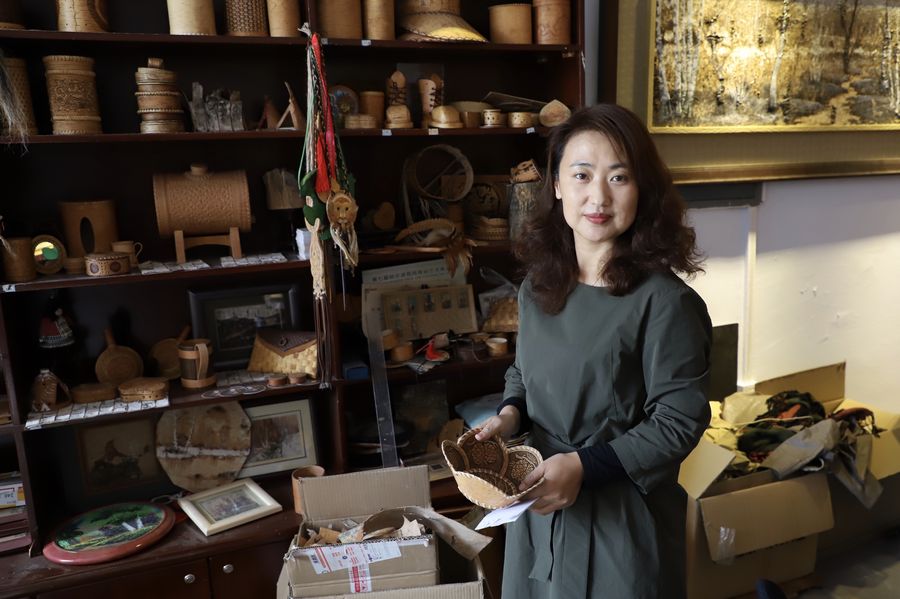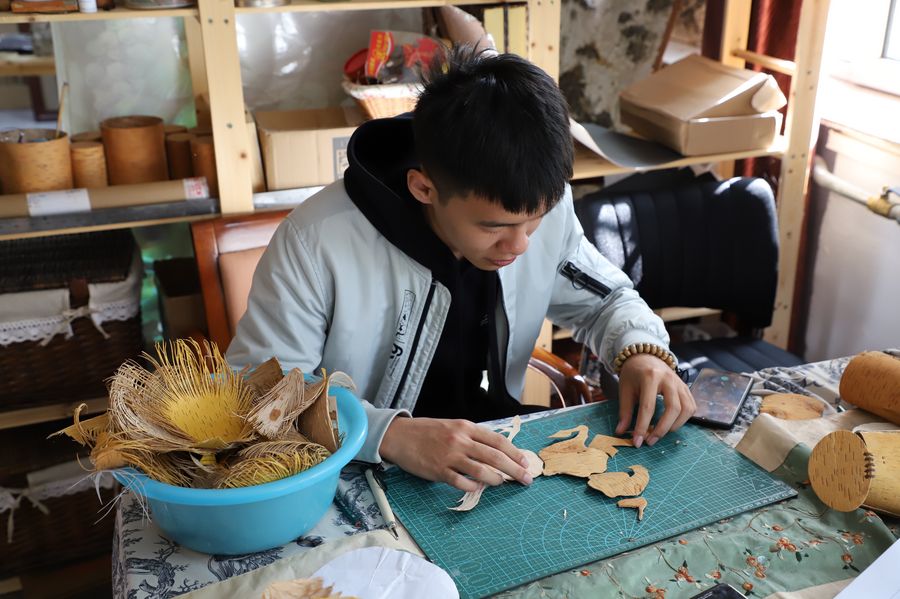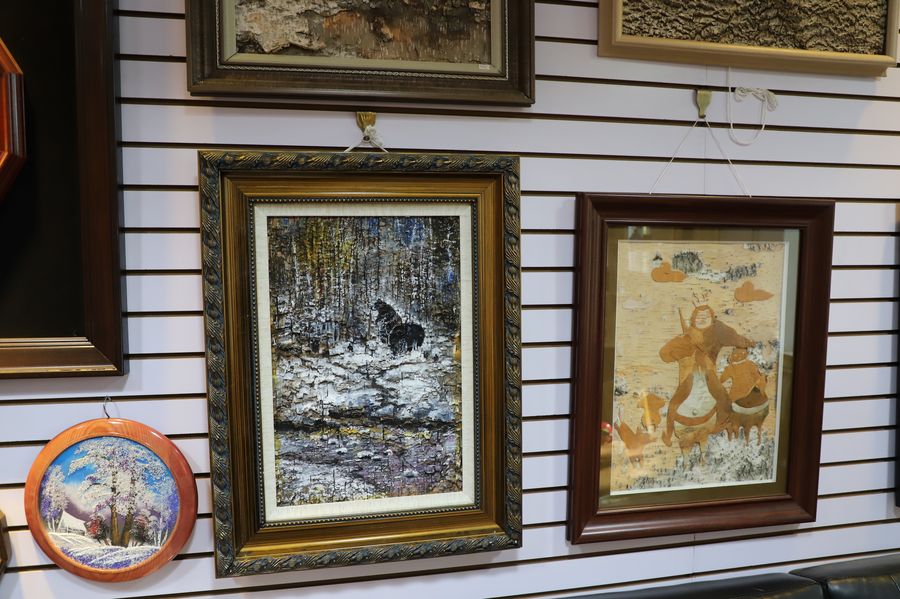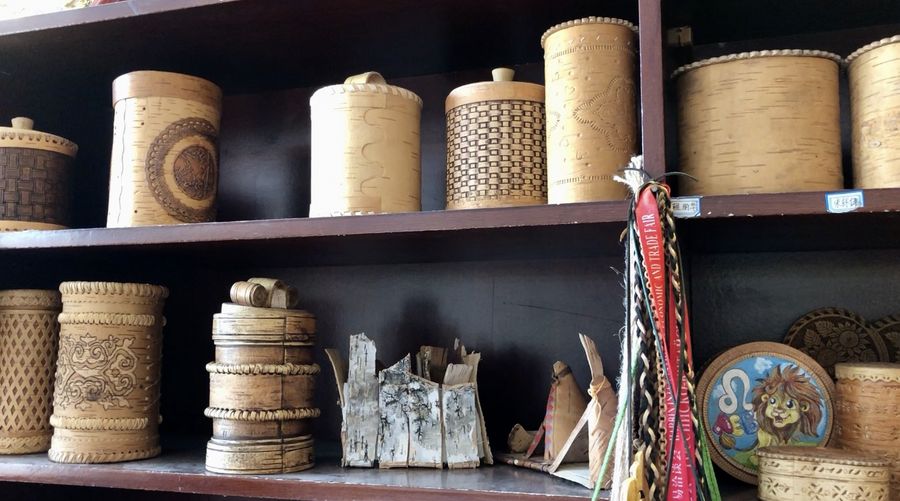
Tao Dandan, inheritor of birch bark craftsmanship, a national intangible cultural heritage, shows birch bark crafts at the College of Fine Art and Design of Heihe University, city of Heihe, northeast China's Heilongjiang Province, Sept. 18, 2019. (Xinhua/Sun Xiaoyu)
One man's trash is another man's treasure. This is especially the case for Tao Dandan, who collects pieces of birch bark dumped by wood processing plants to create handicrafts from the bark using only a chisel and a pair of scissors.
Archaeological studies have found that birch bark culture has a history of over 3,000 years, and is mostly found in areas such as China, Russia and Japan as well as other countries with abundant birch resources.
Traditional birch bark craftsmanship is still preserved by nomadic ethnic minorities living in northeast China. However, as an increasing number of people bid farewell to a nomadic lifestyle, the art is at risk of being lost.
Tao teaches birch bark craftsmanship at the College of Fine Art and Design in Heihe University in the city of Heihe, northeast China's Heilongjiang Province.
Under Tao's guidance, the students painstakingly peel off the outermost hard shell of the birch bark. From there, they continue to peel the birch bark layer by layer, cut the bark into pre-designed patterns and combine the layers together to create a collage.

A student of the College of Fine Art and Design of Heihe University makes birch bark collage, city of Heihe, northeast China's Heilongjiang Province, Sept. 18, 2019. (Xinhua/Sun Xiaoyu)
Born in the city of Heihe in 1978, Tao Dandan inherited her interest in birch bark craftsmanship from her father, Tao Chunlai, a former craftsman. When she was a child, she loved to try and imitate her father's creations.
"One day, I happened to find a small node on the bark. If I add a 'small mouth' and a 'small tail' with my paintbrush, it will look like a bird standing on a stone," Tao said. The sudden inspiration led her to create paintings based on the natural texture of birch bark.
"Before I create a work of art, I can sense the potential 'mountains' and 'rivers' on the birch bark," said Tao. For Tao, every piece of birch bark tells a story and inspires her creativity.

Photo taken on Sept. 18, 2019 shows birch bark paintings on display at the College of Fine Art and Design of Heihe University, city of Heihe, northeast China's Heilongjiang Province. (Xinhua/Sun Xiaoyu)
To improve her skills and search for more inspiration, Tao visited some ethnic minorities in the Hinggan Mountains and north China's Inner Mongolia Autonomous Region, where the art is well preserved.
Birch bark craftsmanship was listed as national intangible cultural heritage in 2006. Two years later, Tao's birch bark craftsmanship was recognized as a provincial intangible cultural heritage inheritance project.
To inherit and develop the birch bark art, Tao started to offer free classes in primary schools to arouse children's interest. She also provided free training for students in vocational schools. So far, Tao has trained hundreds of folk art talents.
In 2017, Tao was invited to work as an associate professor at the College of Fine Arts and Design of the Heihe University.
Ma Mingyu, a student at the college, said that although he had known about birch bark crafts before, he fell in love with the craftsmanship after learning from Tao.

Photo taken on Sept. 18, 2019 shows birch bark crafts on display at the College of Fine Art and Design of Heihe University, city of Heihe, northeast China's Heilongjiang Province. (Xinhua/Liu Heyao)
Tao said students majoring in fine arts and crafts have a solid art foundation, which helps them understand the essence of the craftsmanship. By introducing the traditional craftsmanship to the campus, inspiration from the younger generations endows it with a new life. Tao's students have their graduation birch bark artwork displayed in various venues.
Since 2015, the Heilongjiang Intangible Cultural Heritage Protection Center has successively carried out video recordings of national intangible inheritors over 70 years old. In October 2017, the center recorded the birch bark craft process performed by Fu Zhanxiang, a national intangible cultural heritage inheritor.
Tao said that she is currently making efforts to improve her oil painting skills in order to better present the charm of birch bark with her paintbrush. In the future, she wants to build a birch bark history museum, allowing more people to experience the history and culture of the birch bark art.

